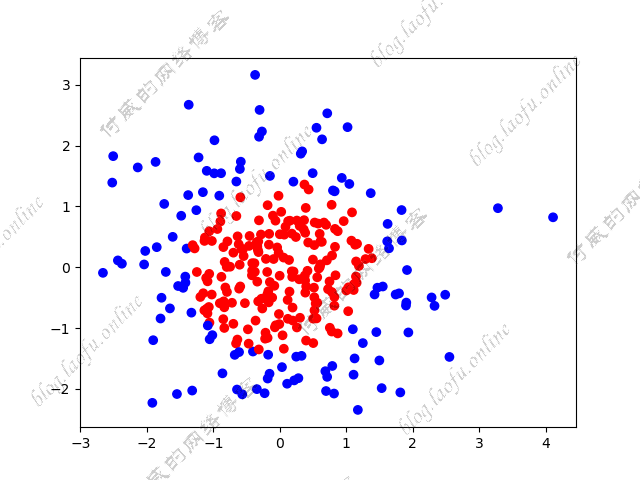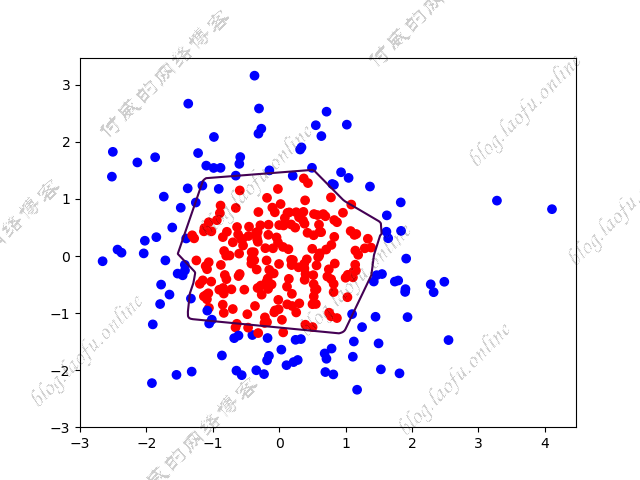Tensorflow的学习笔记--正则化
正则化缓解过拟合
有时候发现,模型在训练数据集的准确率非常高,但很难预测新的数据,这样我们称为,模型存在了过拟合的现象。 正则化是缓解过拟合一种有效的方法.
正则化在损失函数中引入模型复杂度指标,利用给W加权值,弱化训练数据的噪声(一般不正则化b) ,具体公式如下:
其中,模型中所有参数的损失函数如:交叉熵,均方误差 。
用超参数REGULARIZER给出参数w在总loss中的比例,及正则化的权重 w是正则化的参数.
使用tensorflow表示:
1 |
|
我们生成几个随机点,然后利用生成分界线,代码如下:
#coding:utf-8
# 0.导入模块,生成模拟数据集
import tensorflow as tf
import numpy as np
import matplotlib.pyplot as plt
BATCH_SIZE=30
seed=2
# 基于seed产生随机数
rdm=np.random.RandomState(seed)
# 随机数返回300行2列的矩阵,表示300组坐标点(x0,x1)作为输入数据集
X=rdm.randn(300,2)
#从X这个300行2列的矩阵中取出一行,判断如果两个坐标系的平方和小于2,给Y赋值1 其余赋值0.
# 作为输入数据集的标签,
Y_=[int (x0*x0+x1*x1<2) for(x0,x1) in X]
# 遍历Y中的每个元素,1 赋值'red' 其余赋值'blue' ,这样可视化显示是人可以直观区分
Y_c=[['red' if y else 'blue'] for y in Y_]
# 对数据集X和标签Y进行shape整理,第一个元素为-1表示,随第二个参数计算得到,第二个元素表示多少列,把X整理为n行2列,把Y整理为n行1列
X=np.vstack(X).reshape(-1,2)
Y_=np.vstack(Y_).reshape(-1,1)
print(X)
print(Y_)
print(Y_c)
#用plt.sctter画出数据集X各行中第0列元素和第1列元素的点即个行的(x0,x1),用各行Y_c对应的值表示颜色(c是color的缩写)
plt.scatter(X[:,0],X[:,1],c=np.squeeze(Y_c))
plt.show()
x=tf.placeholder(tf.float32,shape=(None,2))
y_=tf.placeholder(tf.float32,shape=(None,1))
def get_weight(shape,regularizer):
w=tf.Variable(tf.random_normal(shape),dtype=tf.float32)
tf.add_to_collection("losses",tf.contrib.layers.l2_regularizer(regularizer)(w))
return w
def get_bias(shape):
b=tf.Variable(tf.constant(0.01,shape=shape))
return b
w1=get_weight([2,11],0.01)
b1=get_bias([11])
y1=tf.nn.relu(tf.matmul(x,w1)+b1)
w2=get_weight([11,1],0.01)
b2=get_bias([1])
y=tf.matmul(y1,w2)+b2
loss_mse=tf.reduce_mean(tf.square(y-y_))
loss_total=loss_mse+tf.add_n(tf.get_collection('losses'))
train_step=tf.train.AdamOptimizer(0.0001).minimize(loss_mse)
with tf.Session() as sess:
init_op=tf.global_variables_initializer()
sess.run(init_op)
STEPS=40000
for i in range(STEPS):
start=(i*BATCH_SIZE)%32
end=start+BATCH_SIZE
sess.run(train_step,feed_dict={
x:X[start:end],y_:Y_[start:end]
})
if i%2000==0:
loss_mse_v=sess.run(loss_mse,feed_dict={x:X,y_:Y_})
print("After %d training steps,loss on all data is %s"%(i,loss_mse_v))
xx,yy=np.mgrid[-3:3:0.1,-3:3:.01]
grid=np.c_[xx.ravel(),yy.ravel()]
probs=sess.run(y,feed_dict={x:grid})
probs=probs.reshape(xx.shape)
print("w1:",sess.run(w1))
print("b1:",sess.run(b1))
print("w2:",sess.run(w2))
print("b2:",sess.run(b2))
plt.scatter(X[:,0],X[:,1],c=np.squeeze(Y_c))
plt.contour(xx,yy,probs,levels=[.5])
plt.show()
生成点的结果如下:
 {:height=”600px” width=”600px”}
{:height=”600px” width=”600px”}
我们拟合的结果为:
 {:height=”600px” width=”600px”}
{:height=”600px” width=”600px”}
使用正则化后,我们拟合的结果为:
 {:height=”600px” width=”600px”}
{:height=”600px” width=”600px”}